The Best 10 Alternatives to WatchGuard Endpoint Security (+ Pricing & Reviews)
Twingate Team
•
Jul 27, 2024

WatchGuard Endpoint Security is a comprehensive solution designed to protect devices against advanced cyber threats through next-gen antivirus, Endpoint Detection & Response (EDR), and DNS filtering. While it offers robust features, it might not be the choice for everyone. This article explores the benefits of secure access solutions for distributed workforces.

10 Alternatives to WatchGuard Endpoint Security
1. Forticlient
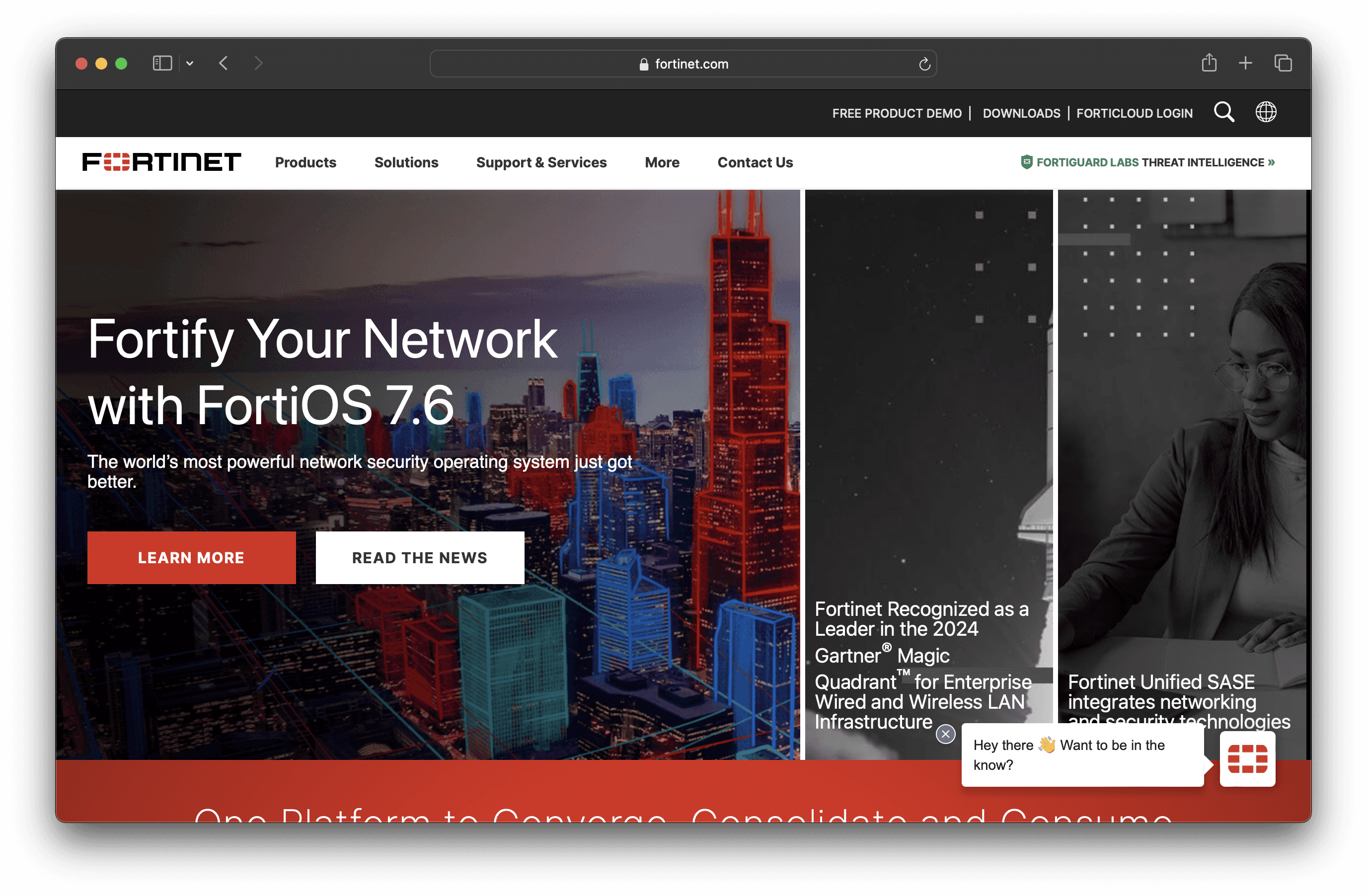
FortiClient is a security solution by Fortinet designed to provide endpoint protection, compliance, and secure access. It integrates with the Fortinet Security Fabric, offering features like ZTNA, web filtering, and automated response. FortiClient aims to simplify management and enhance visibility for businesses of all sizes.
Forticlient Pricing
VPN/ZTNA Edition
EPP/APT Edition
Chromebook Edition
FortiClient's pricing is not public. Contact their support for more info.
Forticlient Reviews
FortiClient has an overall rating of 4.4 out of 5 stars based on 204 reviews. Users praise its ease of use and strong security features. Check out more of our reviews here!
Pros and Cons of Forticlient
Pros:
Unified Security: Combines secure connectivity, endpoint protection, and advanced capabilities like EDR and XDR into a single agent.
Enhanced Visibility and Control: Provides IT teams with visibility and control over endpoints, reducing costs and complexity.
Automated Threat Detection and Response: Minimizes manual intervention and ensures faster remediation of threats.
Cons:
Complexity for Small Organizations: The extensive features and integrations might be overwhelming for smaller organizations with limited IT resources.
Dependency on Fortinet Ecosystem: Full benefits are realized when integrated with other Fortinet products, which may require additional investments.
Learning Curve: Requires training and expertise to fully utilize advanced features and integrations.
2. Symantec
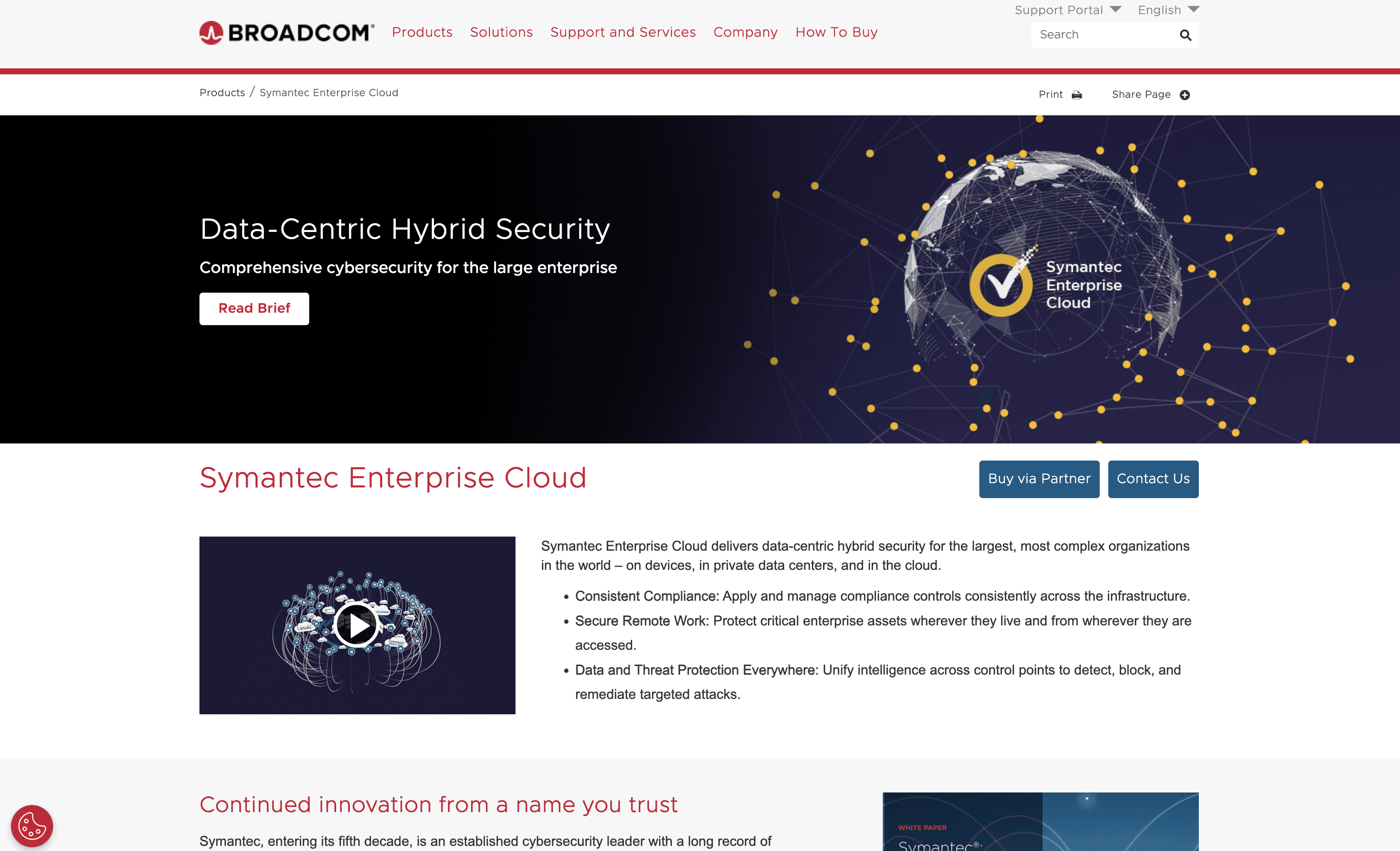
Symantec is a cybersecurity solution designed to protect large enterprises with data-centric hybrid security. It offers comprehensive protection for devices, private data centers, and cloud environments, ensuring consistent compliance and secure remote work. Symantec aims to unify threat intelligence across control points for effective threat detection and remediation.
Symantec Pricing
Symantec's pricing is not public. Contact their support for more info.
Symantec Reviews
Symantec has an overall rating of 4.3 out of 5 stars based on 37 reviews. Users appreciate its robust protection and ease of use. Check out more of our reviews here!
Pros and Cons ofSymantec
Pros:
Comprehensive Security: Offers extensive protection across endpoints, networks, information, and email security.
Consistent Compliance: Ensures compliance controls are uniformly applied across the entire infrastructure.
Secure Remote Work: Safeguards enterprise assets regardless of their location, supporting remote work environments.
Cons:
Complexity for Small Businesses: The extensive features may be overwhelming for smaller organizations with limited IT resources.
Potential High Costs: Advanced security solutions may come with higher costs, posing a barrier for some organizations.
Integration Challenges: Integrating third-party products might require significant effort and expertise.
3. Sophos Intercept X Endpoint Protection
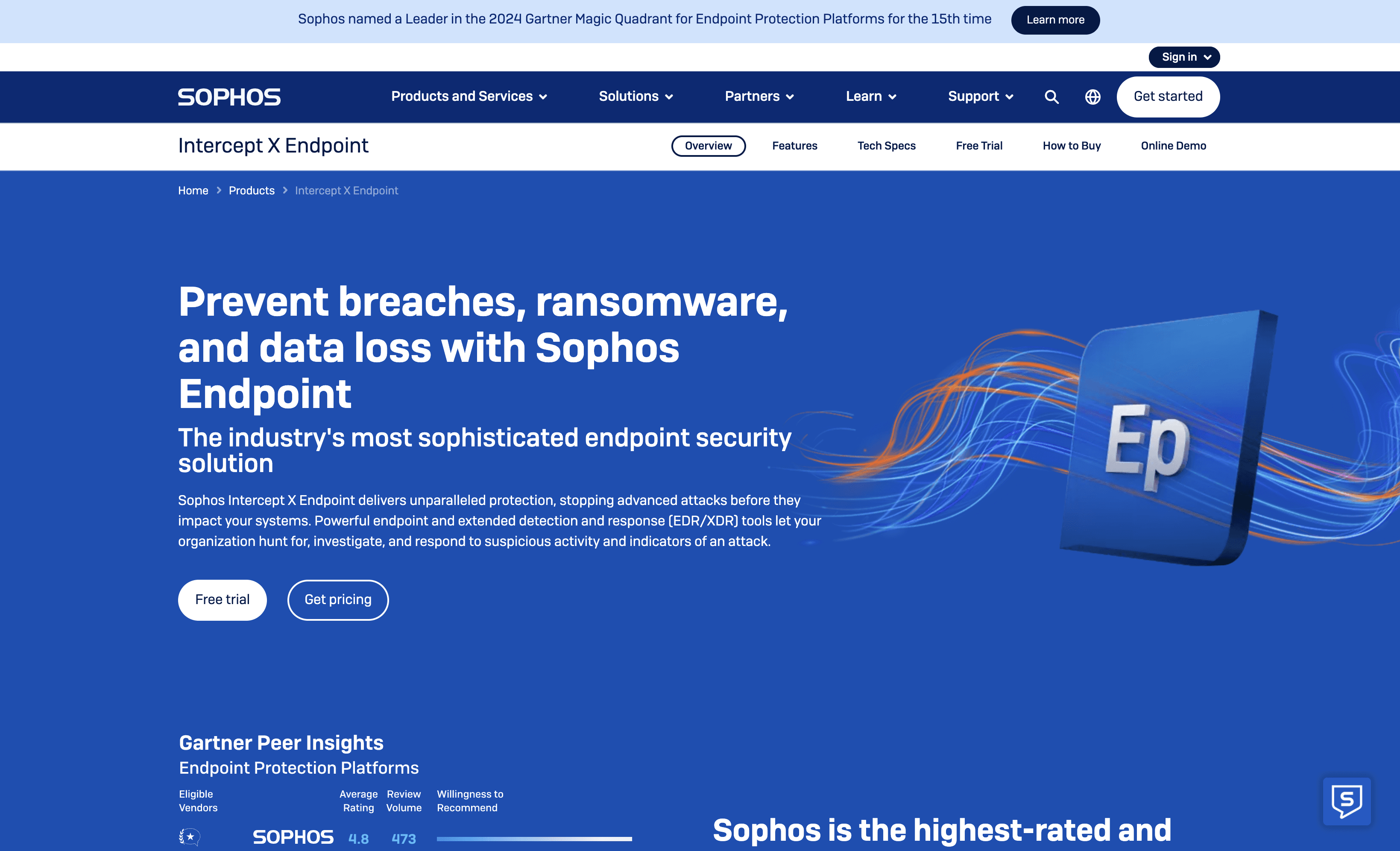
Sophos Intercept X Endpoint Protection is a security solution designed to prevent breaches, ransomware, and data loss. It combines advanced features like Endpoint Detection and Response (EDR) and Extended Detection and Response (XDR) with ease of use, making it suitable for businesses of all sizes.
Sophos Intercept X Endpoint Protection Pricing
Sophos Intercept X Endpoint Protection's pricing is not public. Contact their support for more info.
Sophos Intercept X Endpoint Protection Reviews
Sophos Intercept X Endpoint Protection has an overall rating of 3.9 out of 5 stars based on 30 reviews. Users appreciate its ease of use and effective ransomware protection. Check out more of our reviews here!
Pros and Cons of Sophos Intercept X Endpoint Protection
Pros:
Effective Ransomware Protection: CryptoGuard technology stops malicious encryption in real-time and rolls back affected files.
Ease of Use: Users find the product easy to install and navigate, making it accessible for various skill levels.
Comprehensive Security: Uses AI, behavioral analysis, and anti-exploitation technologies to provide robust protection against advanced threats.
Cons:
False Positives: Occasionally flags legitimate applications as threats, requiring manual intervention to resolve.
Complexity for Small Teams: The advanced features might be overwhelming for small IT teams without dedicated security personnel.
Potential Performance Impact: Extensive security measures and real-time analysis might slow down older hardware.
4. Huntress Managed EDR
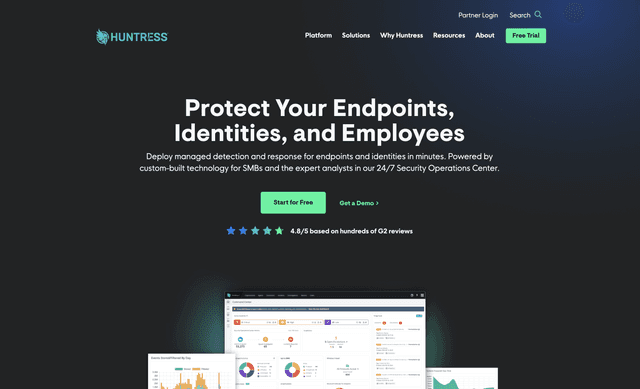
Huntress Managed EDR is a cybersecurity solution designed for small and medium-sized businesses and IT providers. It offers full visibility, detection, and response for endpoints, ensuring robust protection against cyber threats. With easy deployment and 24/7 expert support, Huntress aims to simplify endpoint security management.
Huntress Managed EDR Pricing
Huntress Managed EDR's pricing is not public. Contact their support for more info.
Huntress Managed EDR Reviews
Huntress Managed EDR has an overall rating of 4.9 out of 5 stars based on 663 reviews. Users appreciate its excellent customer support and ease of use. Check out more of our reviews here!
Pros and Cons of Huntress Managed EDR
Pros:
Customer Support: Exceptional 24/7 support from expert analysts, ensuring quick and effective threat resolution.
Ease of Use: Intuitive interface and straightforward deployment, making it accessible for SMBs with limited IT resources.
Threat Detection: Advanced detection capabilities provide full visibility and rapid response to emerging threats.
Cons:
False Positives: Occasionally flags legitimate activities as threats, requiring manual intervention to resolve.
Defender Dependence: Relies heavily on Microsoft Defender, which may not suit all environments.
Expensive: Higher cost may be a barrier for budget-conscious small businesses.
5. Eset Endpoint Protection Advanced

ESET Endpoint Protection Advanced is a multi-layered security solution designed to protect company networks and mobile workforces. It offers robust antivirus, mobile security, and remote management features, ensuring comprehensive protection across various devices and platforms. ESET aims to provide an easy-to-use and effective security solution for businesses of all sizes.
Eset Endpoint Protection Advanced Pricing
ESET Endpoint Protection Advanced
ESET Secure Business
ESET Secure Enterprise
ESET Endpoint Protection Standard
Eset Endpoint Protection Advanced's pricing is not public. Contact their support for more info.
Eset Endpoint Protection Advanced Reviews
Eset Endpoint Protection Advanced has an overall rating of 4.6 out of 5 stars based on 814 reviews. Users appreciate its high security and ease of use. Check out more of our reviews here!
Pros and Cons of Eset Endpoint Protection Advanced
Pros:
Multi-layered Security: Comprehensive protection with features like Web Control, Firewall, and Anti-Spam filter.
Endpoint Antivirus: Robust protection for Windows, macOS, and Linux endpoints, including Anti-Phishing and Cloud-Powered Scanning.
Mobile Security: Real-time protection for Android and iOS devices, including Anti-Phishing, Application Control, and Anti-Theft features.
Cons:
Complexity: Multi-layered security solutions can be complex to configure and manage, especially for smaller businesses without dedicated IT staff.
Cost: Advanced security solutions often come with higher costs, which might be a consideration for budget-conscious businesses.
Resource Usage: Although the product claims to leave more system resources for essential programs, some users might still experience performance impacts on older or less powerful hardware.
6. McAfee
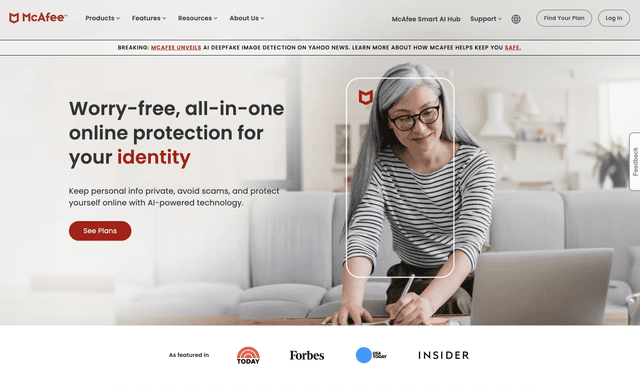
McAfee is a cybersecurity solution designed to protect devices and personal information with AI-powered technology. It offers features like advanced privacy protection, identity and financial security, and real-time antivirus. McAfee aims to provide comprehensive online protection for individuals and families.
McAfee Pricing
McAfee Total Protection: $39.99 (discounted from $119.99)
Installment Option: Four payments of $10.00 each
McAfee Reviews
McAfee has an overall rating of 4.3 out of 5 stars based on 281 reviews. Users appreciate its comprehensive security features and ease of installation. Check out more of our reviews here!
Pros and Cons of McAfee
Pros:
Advanced Privacy Protection: Secure VPN and Personal Data Cleanup ensure your personal information remains private and protected from unauthorized access.
Identity and Financial Protection: 24/7 monitoring, timely alerts, and up to $2 million in identity theft coverage provide comprehensive security.
AI-Powered Antivirus: Real-time protection against viruses, hackers, and risky links keeps your devices safe from emerging threats.
Cons:
Performance Issues: McAfee's security applications can consume significant memory and CPU resources, potentially slowing down your system.
User Experience: The interface can be challenging to navigate, especially for users without prior training or experience.
Notifications and Disruptions: Excessive notifications, especially near subscription expiration, can be disruptive and annoying.
7. Vipre EDR
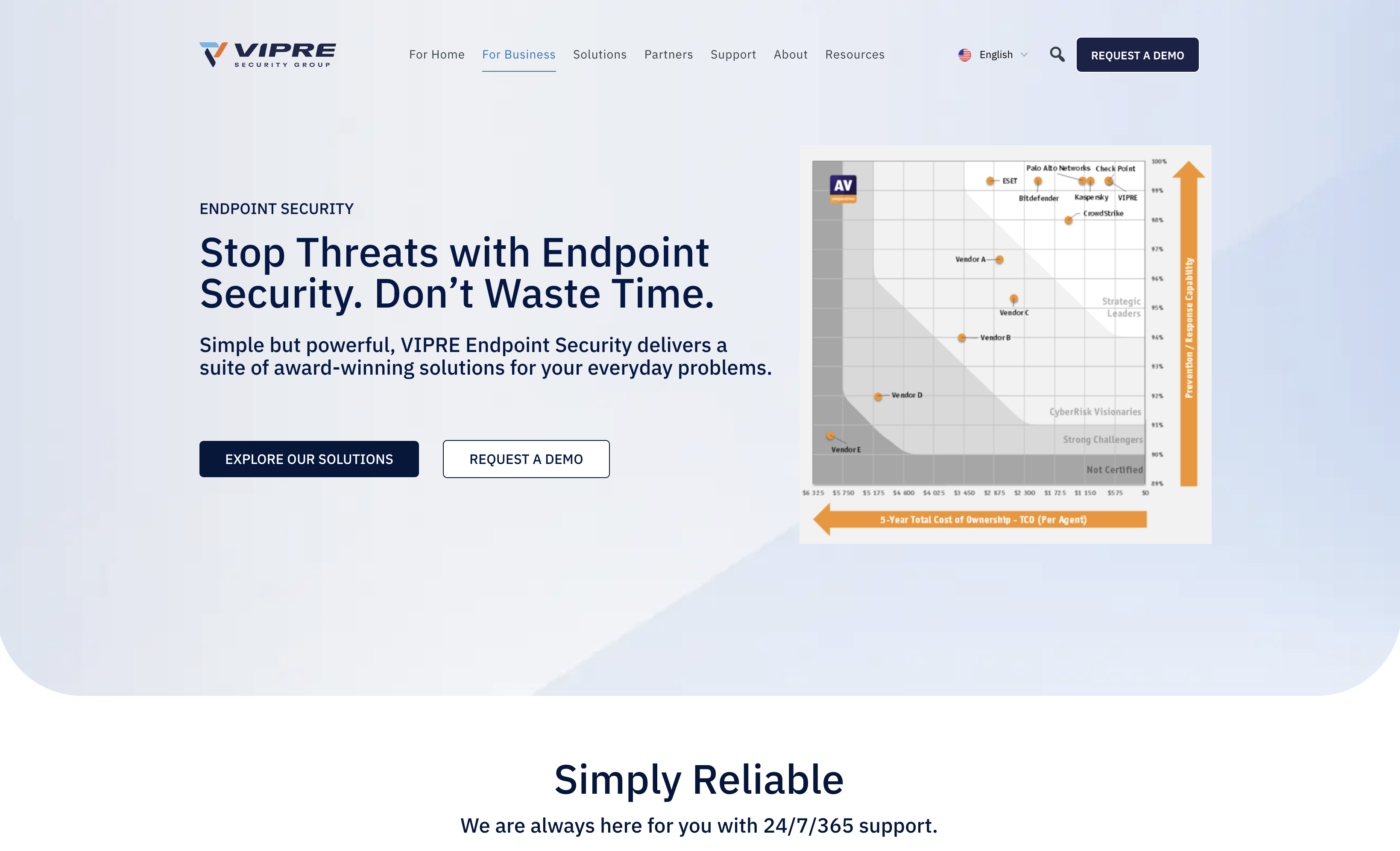
Vipre EDR is a cybersecurity solution designed to provide comprehensive endpoint detection and response. It focuses on simplicity, reliability, and effectiveness, offering features like ransomware prevention, AI-powered investigation, and mobile accessibility. Vipre EDR aims to deliver robust protection for businesses of all sizes.
Vipre EDR Pricing
Vipre EDR's pricing is not public. Contact their support for more info.
Vipre EDR Reviews
Vipre EDR has an overall rating of 4.5 out of 5 stars based on 50 reviews. Users appreciate its simplicity and reliability. Check out more of our reviews here!
Pros and Cons of Vipre EDR
Pros:
Ease of Installation and Use: Advanced functionality combined with simple installation makes it accessible for all users.
Ransomware Prevention and Rollback: Real-time behavior monitoring and AI detect, prevent, and roll back ransomware effectively.
Complete View of Threat Behavior: Centralized threat behavior monitoring ensures rapid remediation and comprehensive security.
Cons:
Limited Reviews: Insufficient user reviews make it challenging to gauge comprehensive buying insights.
Limited Features on Claimed Profile: Some features may require an upgraded plan, limiting initial functionality.
Security Information Not Added: Absence of detailed security information might concern potential buyers.
8. Avast Endpoint Protection

Avast Endpoint Protection is a cybersecurity solution designed to safeguard business networks and devices. It offers comprehensive protection against malware, ransomware, and other cyber threats. With easy deployment and user-friendly management, Avast aims to provide robust security for businesses of all sizes.
Avast Endpoint Protection Pricing
Avast Essential Business Security: $148.36 per year
Avast Premium Business Security: $187.00 per year
Avast Ultimate Business Security: $227.08 per year
Avast Endpoint Protection Reviews
Avast Endpoint Protection has an overall rating of 4.4 out of 5 stars based on 101 reviews. Users appreciate its extensive protection tools and user-friendly interface. Check out more of our reviews here!
Pros and Cons of Avast Endpoint Protection
Pros:
Comprehensive Protection: Offers antivirus, VPN, and cleanup tools, ensuring all-around security for your devices.
Easy to Install and Use: Designed for effortless setup and operation, making it accessible for all users.
Real-time Threat Detection: Blocks phishing, scam threats, and malware in real-time, providing robust security.
Cons:
Performance Impact: May slow down system performance, especially on older hardware.
Potential False Positives: Occasionally flags legitimate software as malicious, requiring manual intervention.
Subscription Costs: Advanced features come with a cost, which might deter budget-conscious users.
9. Cisco Secure Endpoint

Cisco Secure Endpoint is a cloud-native solution designed to provide advanced endpoint security. It focuses on quick detection, response, and recovery from attacks, reducing remediation times significantly. With features like EDR, threat hunting, and integration with Cisco's SecureX platform, it aims to offer comprehensive protection for businesses of all sizes.
Cisco Secure Endpoint Pricing
Cisco Secure Endpoint's pricing is not public. Contact their support for more info.
Cisco Secure Endpoint Reviews
Cisco Secure Endpoint has an overall rating of 4.5 out of 5 stars based on 21 reviews. Users appreciate its ease of use and fast threat detection. Check out more of our reviews here!
Pros and Cons of Cisco Secure Endpoint
Pros:
Powerful EDR Capabilities: Advanced endpoint detection and response, threat hunting, and risk-based vulnerability management.
Streamlined Investigations: Orbital Advanced Search provides quick answers about endpoints, simplifying investigations.
Integrated XDR Capabilities: Unified view and automated playbooks with SecureX platform for efficient incident management.
Cons:
Complexity: Advanced features and integrations may require a steep learning curve for new users.
Cost: Enterprise-level security solutions can be expensive, potentially limiting accessibility for smaller businesses.
Resource Intensive: Significant system resources and infrastructure may be required for optimal operation.
10. F-Secure Elements
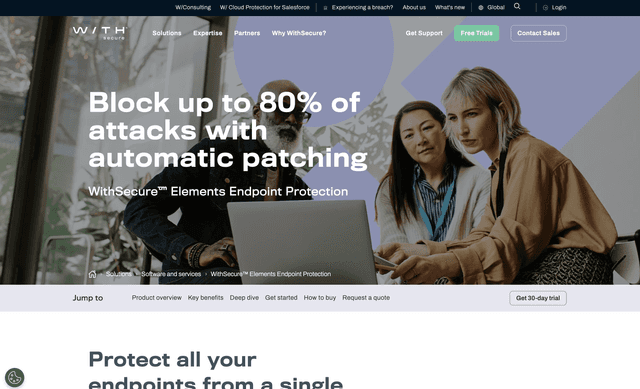
F-Secure Elements is a cloud-native security solution designed to protect endpoints with AI-powered technology. It offers comprehensive protection, easy deployment, and centralized management, making it suitable for businesses of all sizes. F-Secure Elements aims to provide robust security while minimizing complexity and maintenance efforts.
F-Secure Elements Pricing
F-Secure Elements's pricing is not public. Contact their support for more info.
F-Secure Elements Reviews
F-Secure Elements has an overall rating of 4.4 out of 5 stars based on 17 reviews. Users appreciate its robust threat detection and ease of deployment. Check out more of our reviews here!
Pros and Cons of F-Secure Elements
Pros:
Automated Patch Management: Blocks up to 80% of ransomware attacks, ensuring robust protection.
Cloud-Native: Simplifies deployment, management, and monitoring, saving valuable time and resources.
Multi-Engine Malware Protection: Offers comprehensive defense against diverse malware threats.
Cons:
Expensive: High costs may deter budget-conscious businesses from adopting the solution.
Complex Interface: The user interface can be challenging to navigate for those unfamiliar with security software.
Poor Support Services: Users report dissatisfaction with the quality and responsiveness of customer support.
Looking to secure your technical infrastructure?
Twingate offers granular access controls and deployment automations to protect your VPC environment. By leveraging Zero Trust security tools, Twingate ensures that private resources and internet traffic remain secure in the modern world of work. Try Twingate for Free today!
Rapidly implement a modern Zero Trust network that is more secure and maintainable than VPNs.
The Best 10 Alternatives to WatchGuard Endpoint Security (+ Pricing & Reviews)
Twingate Team
•
Jul 27, 2024

WatchGuard Endpoint Security is a comprehensive solution designed to protect devices against advanced cyber threats through next-gen antivirus, Endpoint Detection & Response (EDR), and DNS filtering. While it offers robust features, it might not be the choice for everyone. This article explores the benefits of secure access solutions for distributed workforces.

10 Alternatives to WatchGuard Endpoint Security
1. Forticlient

FortiClient is a security solution by Fortinet designed to provide endpoint protection, compliance, and secure access. It integrates with the Fortinet Security Fabric, offering features like ZTNA, web filtering, and automated response. FortiClient aims to simplify management and enhance visibility for businesses of all sizes.
Forticlient Pricing
VPN/ZTNA Edition
EPP/APT Edition
Chromebook Edition
FortiClient's pricing is not public. Contact their support for more info.
Forticlient Reviews
FortiClient has an overall rating of 4.4 out of 5 stars based on 204 reviews. Users praise its ease of use and strong security features. Check out more of our reviews here!
Pros and Cons of Forticlient
Pros:
Unified Security: Combines secure connectivity, endpoint protection, and advanced capabilities like EDR and XDR into a single agent.
Enhanced Visibility and Control: Provides IT teams with visibility and control over endpoints, reducing costs and complexity.
Automated Threat Detection and Response: Minimizes manual intervention and ensures faster remediation of threats.
Cons:
Complexity for Small Organizations: The extensive features and integrations might be overwhelming for smaller organizations with limited IT resources.
Dependency on Fortinet Ecosystem: Full benefits are realized when integrated with other Fortinet products, which may require additional investments.
Learning Curve: Requires training and expertise to fully utilize advanced features and integrations.
2. Symantec

Symantec is a cybersecurity solution designed to protect large enterprises with data-centric hybrid security. It offers comprehensive protection for devices, private data centers, and cloud environments, ensuring consistent compliance and secure remote work. Symantec aims to unify threat intelligence across control points for effective threat detection and remediation.
Symantec Pricing
Symantec's pricing is not public. Contact their support for more info.
Symantec Reviews
Symantec has an overall rating of 4.3 out of 5 stars based on 37 reviews. Users appreciate its robust protection and ease of use. Check out more of our reviews here!
Pros and Cons ofSymantec
Pros:
Comprehensive Security: Offers extensive protection across endpoints, networks, information, and email security.
Consistent Compliance: Ensures compliance controls are uniformly applied across the entire infrastructure.
Secure Remote Work: Safeguards enterprise assets regardless of their location, supporting remote work environments.
Cons:
Complexity for Small Businesses: The extensive features may be overwhelming for smaller organizations with limited IT resources.
Potential High Costs: Advanced security solutions may come with higher costs, posing a barrier for some organizations.
Integration Challenges: Integrating third-party products might require significant effort and expertise.
3. Sophos Intercept X Endpoint Protection

Sophos Intercept X Endpoint Protection is a security solution designed to prevent breaches, ransomware, and data loss. It combines advanced features like Endpoint Detection and Response (EDR) and Extended Detection and Response (XDR) with ease of use, making it suitable for businesses of all sizes.
Sophos Intercept X Endpoint Protection Pricing
Sophos Intercept X Endpoint Protection's pricing is not public. Contact their support for more info.
Sophos Intercept X Endpoint Protection Reviews
Sophos Intercept X Endpoint Protection has an overall rating of 3.9 out of 5 stars based on 30 reviews. Users appreciate its ease of use and effective ransomware protection. Check out more of our reviews here!
Pros and Cons of Sophos Intercept X Endpoint Protection
Pros:
Effective Ransomware Protection: CryptoGuard technology stops malicious encryption in real-time and rolls back affected files.
Ease of Use: Users find the product easy to install and navigate, making it accessible for various skill levels.
Comprehensive Security: Uses AI, behavioral analysis, and anti-exploitation technologies to provide robust protection against advanced threats.
Cons:
False Positives: Occasionally flags legitimate applications as threats, requiring manual intervention to resolve.
Complexity for Small Teams: The advanced features might be overwhelming for small IT teams without dedicated security personnel.
Potential Performance Impact: Extensive security measures and real-time analysis might slow down older hardware.
4. Huntress Managed EDR

Huntress Managed EDR is a cybersecurity solution designed for small and medium-sized businesses and IT providers. It offers full visibility, detection, and response for endpoints, ensuring robust protection against cyber threats. With easy deployment and 24/7 expert support, Huntress aims to simplify endpoint security management.
Huntress Managed EDR Pricing
Huntress Managed EDR's pricing is not public. Contact their support for more info.
Huntress Managed EDR Reviews
Huntress Managed EDR has an overall rating of 4.9 out of 5 stars based on 663 reviews. Users appreciate its excellent customer support and ease of use. Check out more of our reviews here!
Pros and Cons of Huntress Managed EDR
Pros:
Customer Support: Exceptional 24/7 support from expert analysts, ensuring quick and effective threat resolution.
Ease of Use: Intuitive interface and straightforward deployment, making it accessible for SMBs with limited IT resources.
Threat Detection: Advanced detection capabilities provide full visibility and rapid response to emerging threats.
Cons:
False Positives: Occasionally flags legitimate activities as threats, requiring manual intervention to resolve.
Defender Dependence: Relies heavily on Microsoft Defender, which may not suit all environments.
Expensive: Higher cost may be a barrier for budget-conscious small businesses.
5. Eset Endpoint Protection Advanced

ESET Endpoint Protection Advanced is a multi-layered security solution designed to protect company networks and mobile workforces. It offers robust antivirus, mobile security, and remote management features, ensuring comprehensive protection across various devices and platforms. ESET aims to provide an easy-to-use and effective security solution for businesses of all sizes.
Eset Endpoint Protection Advanced Pricing
ESET Endpoint Protection Advanced
ESET Secure Business
ESET Secure Enterprise
ESET Endpoint Protection Standard
Eset Endpoint Protection Advanced's pricing is not public. Contact their support for more info.
Eset Endpoint Protection Advanced Reviews
Eset Endpoint Protection Advanced has an overall rating of 4.6 out of 5 stars based on 814 reviews. Users appreciate its high security and ease of use. Check out more of our reviews here!
Pros and Cons of Eset Endpoint Protection Advanced
Pros:
Multi-layered Security: Comprehensive protection with features like Web Control, Firewall, and Anti-Spam filter.
Endpoint Antivirus: Robust protection for Windows, macOS, and Linux endpoints, including Anti-Phishing and Cloud-Powered Scanning.
Mobile Security: Real-time protection for Android and iOS devices, including Anti-Phishing, Application Control, and Anti-Theft features.
Cons:
Complexity: Multi-layered security solutions can be complex to configure and manage, especially for smaller businesses without dedicated IT staff.
Cost: Advanced security solutions often come with higher costs, which might be a consideration for budget-conscious businesses.
Resource Usage: Although the product claims to leave more system resources for essential programs, some users might still experience performance impacts on older or less powerful hardware.
6. McAfee

McAfee is a cybersecurity solution designed to protect devices and personal information with AI-powered technology. It offers features like advanced privacy protection, identity and financial security, and real-time antivirus. McAfee aims to provide comprehensive online protection for individuals and families.
McAfee Pricing
McAfee Total Protection: $39.99 (discounted from $119.99)
Installment Option: Four payments of $10.00 each
McAfee Reviews
McAfee has an overall rating of 4.3 out of 5 stars based on 281 reviews. Users appreciate its comprehensive security features and ease of installation. Check out more of our reviews here!
Pros and Cons of McAfee
Pros:
Advanced Privacy Protection: Secure VPN and Personal Data Cleanup ensure your personal information remains private and protected from unauthorized access.
Identity and Financial Protection: 24/7 monitoring, timely alerts, and up to $2 million in identity theft coverage provide comprehensive security.
AI-Powered Antivirus: Real-time protection against viruses, hackers, and risky links keeps your devices safe from emerging threats.
Cons:
Performance Issues: McAfee's security applications can consume significant memory and CPU resources, potentially slowing down your system.
User Experience: The interface can be challenging to navigate, especially for users without prior training or experience.
Notifications and Disruptions: Excessive notifications, especially near subscription expiration, can be disruptive and annoying.
7. Vipre EDR

Vipre EDR is a cybersecurity solution designed to provide comprehensive endpoint detection and response. It focuses on simplicity, reliability, and effectiveness, offering features like ransomware prevention, AI-powered investigation, and mobile accessibility. Vipre EDR aims to deliver robust protection for businesses of all sizes.
Vipre EDR Pricing
Vipre EDR's pricing is not public. Contact their support for more info.
Vipre EDR Reviews
Vipre EDR has an overall rating of 4.5 out of 5 stars based on 50 reviews. Users appreciate its simplicity and reliability. Check out more of our reviews here!
Pros and Cons of Vipre EDR
Pros:
Ease of Installation and Use: Advanced functionality combined with simple installation makes it accessible for all users.
Ransomware Prevention and Rollback: Real-time behavior monitoring and AI detect, prevent, and roll back ransomware effectively.
Complete View of Threat Behavior: Centralized threat behavior monitoring ensures rapid remediation and comprehensive security.
Cons:
Limited Reviews: Insufficient user reviews make it challenging to gauge comprehensive buying insights.
Limited Features on Claimed Profile: Some features may require an upgraded plan, limiting initial functionality.
Security Information Not Added: Absence of detailed security information might concern potential buyers.
8. Avast Endpoint Protection

Avast Endpoint Protection is a cybersecurity solution designed to safeguard business networks and devices. It offers comprehensive protection against malware, ransomware, and other cyber threats. With easy deployment and user-friendly management, Avast aims to provide robust security for businesses of all sizes.
Avast Endpoint Protection Pricing
Avast Essential Business Security: $148.36 per year
Avast Premium Business Security: $187.00 per year
Avast Ultimate Business Security: $227.08 per year
Avast Endpoint Protection Reviews
Avast Endpoint Protection has an overall rating of 4.4 out of 5 stars based on 101 reviews. Users appreciate its extensive protection tools and user-friendly interface. Check out more of our reviews here!
Pros and Cons of Avast Endpoint Protection
Pros:
Comprehensive Protection: Offers antivirus, VPN, and cleanup tools, ensuring all-around security for your devices.
Easy to Install and Use: Designed for effortless setup and operation, making it accessible for all users.
Real-time Threat Detection: Blocks phishing, scam threats, and malware in real-time, providing robust security.
Cons:
Performance Impact: May slow down system performance, especially on older hardware.
Potential False Positives: Occasionally flags legitimate software as malicious, requiring manual intervention.
Subscription Costs: Advanced features come with a cost, which might deter budget-conscious users.
9. Cisco Secure Endpoint

Cisco Secure Endpoint is a cloud-native solution designed to provide advanced endpoint security. It focuses on quick detection, response, and recovery from attacks, reducing remediation times significantly. With features like EDR, threat hunting, and integration with Cisco's SecureX platform, it aims to offer comprehensive protection for businesses of all sizes.
Cisco Secure Endpoint Pricing
Cisco Secure Endpoint's pricing is not public. Contact their support for more info.
Cisco Secure Endpoint Reviews
Cisco Secure Endpoint has an overall rating of 4.5 out of 5 stars based on 21 reviews. Users appreciate its ease of use and fast threat detection. Check out more of our reviews here!
Pros and Cons of Cisco Secure Endpoint
Pros:
Powerful EDR Capabilities: Advanced endpoint detection and response, threat hunting, and risk-based vulnerability management.
Streamlined Investigations: Orbital Advanced Search provides quick answers about endpoints, simplifying investigations.
Integrated XDR Capabilities: Unified view and automated playbooks with SecureX platform for efficient incident management.
Cons:
Complexity: Advanced features and integrations may require a steep learning curve for new users.
Cost: Enterprise-level security solutions can be expensive, potentially limiting accessibility for smaller businesses.
Resource Intensive: Significant system resources and infrastructure may be required for optimal operation.
10. F-Secure Elements

F-Secure Elements is a cloud-native security solution designed to protect endpoints with AI-powered technology. It offers comprehensive protection, easy deployment, and centralized management, making it suitable for businesses of all sizes. F-Secure Elements aims to provide robust security while minimizing complexity and maintenance efforts.
F-Secure Elements Pricing
F-Secure Elements's pricing is not public. Contact their support for more info.
F-Secure Elements Reviews
F-Secure Elements has an overall rating of 4.4 out of 5 stars based on 17 reviews. Users appreciate its robust threat detection and ease of deployment. Check out more of our reviews here!
Pros and Cons of F-Secure Elements
Pros:
Automated Patch Management: Blocks up to 80% of ransomware attacks, ensuring robust protection.
Cloud-Native: Simplifies deployment, management, and monitoring, saving valuable time and resources.
Multi-Engine Malware Protection: Offers comprehensive defense against diverse malware threats.
Cons:
Expensive: High costs may deter budget-conscious businesses from adopting the solution.
Complex Interface: The user interface can be challenging to navigate for those unfamiliar with security software.
Poor Support Services: Users report dissatisfaction with the quality and responsiveness of customer support.
Looking to secure your technical infrastructure?
Twingate offers granular access controls and deployment automations to protect your VPC environment. By leveraging Zero Trust security tools, Twingate ensures that private resources and internet traffic remain secure in the modern world of work. Try Twingate for Free today!
Rapidly implement a modern Zero Trust network that is more secure and maintainable than VPNs.
The Best 10 Alternatives to WatchGuard Endpoint Security (+ Pricing & Reviews)
Twingate Team
•
Jul 27, 2024

WatchGuard Endpoint Security is a comprehensive solution designed to protect devices against advanced cyber threats through next-gen antivirus, Endpoint Detection & Response (EDR), and DNS filtering. While it offers robust features, it might not be the choice for everyone. This article explores the benefits of secure access solutions for distributed workforces.

10 Alternatives to WatchGuard Endpoint Security
1. Forticlient

FortiClient is a security solution by Fortinet designed to provide endpoint protection, compliance, and secure access. It integrates with the Fortinet Security Fabric, offering features like ZTNA, web filtering, and automated response. FortiClient aims to simplify management and enhance visibility for businesses of all sizes.
Forticlient Pricing
VPN/ZTNA Edition
EPP/APT Edition
Chromebook Edition
FortiClient's pricing is not public. Contact their support for more info.
Forticlient Reviews
FortiClient has an overall rating of 4.4 out of 5 stars based on 204 reviews. Users praise its ease of use and strong security features. Check out more of our reviews here!
Pros and Cons of Forticlient
Pros:
Unified Security: Combines secure connectivity, endpoint protection, and advanced capabilities like EDR and XDR into a single agent.
Enhanced Visibility and Control: Provides IT teams with visibility and control over endpoints, reducing costs and complexity.
Automated Threat Detection and Response: Minimizes manual intervention and ensures faster remediation of threats.
Cons:
Complexity for Small Organizations: The extensive features and integrations might be overwhelming for smaller organizations with limited IT resources.
Dependency on Fortinet Ecosystem: Full benefits are realized when integrated with other Fortinet products, which may require additional investments.
Learning Curve: Requires training and expertise to fully utilize advanced features and integrations.
2. Symantec

Symantec is a cybersecurity solution designed to protect large enterprises with data-centric hybrid security. It offers comprehensive protection for devices, private data centers, and cloud environments, ensuring consistent compliance and secure remote work. Symantec aims to unify threat intelligence across control points for effective threat detection and remediation.
Symantec Pricing
Symantec's pricing is not public. Contact their support for more info.
Symantec Reviews
Symantec has an overall rating of 4.3 out of 5 stars based on 37 reviews. Users appreciate its robust protection and ease of use. Check out more of our reviews here!
Pros and Cons ofSymantec
Pros:
Comprehensive Security: Offers extensive protection across endpoints, networks, information, and email security.
Consistent Compliance: Ensures compliance controls are uniformly applied across the entire infrastructure.
Secure Remote Work: Safeguards enterprise assets regardless of their location, supporting remote work environments.
Cons:
Complexity for Small Businesses: The extensive features may be overwhelming for smaller organizations with limited IT resources.
Potential High Costs: Advanced security solutions may come with higher costs, posing a barrier for some organizations.
Integration Challenges: Integrating third-party products might require significant effort and expertise.
3. Sophos Intercept X Endpoint Protection

Sophos Intercept X Endpoint Protection is a security solution designed to prevent breaches, ransomware, and data loss. It combines advanced features like Endpoint Detection and Response (EDR) and Extended Detection and Response (XDR) with ease of use, making it suitable for businesses of all sizes.
Sophos Intercept X Endpoint Protection Pricing
Sophos Intercept X Endpoint Protection's pricing is not public. Contact their support for more info.
Sophos Intercept X Endpoint Protection Reviews
Sophos Intercept X Endpoint Protection has an overall rating of 3.9 out of 5 stars based on 30 reviews. Users appreciate its ease of use and effective ransomware protection. Check out more of our reviews here!
Pros and Cons of Sophos Intercept X Endpoint Protection
Pros:
Effective Ransomware Protection: CryptoGuard technology stops malicious encryption in real-time and rolls back affected files.
Ease of Use: Users find the product easy to install and navigate, making it accessible for various skill levels.
Comprehensive Security: Uses AI, behavioral analysis, and anti-exploitation technologies to provide robust protection against advanced threats.
Cons:
False Positives: Occasionally flags legitimate applications as threats, requiring manual intervention to resolve.
Complexity for Small Teams: The advanced features might be overwhelming for small IT teams without dedicated security personnel.
Potential Performance Impact: Extensive security measures and real-time analysis might slow down older hardware.
4. Huntress Managed EDR

Huntress Managed EDR is a cybersecurity solution designed for small and medium-sized businesses and IT providers. It offers full visibility, detection, and response for endpoints, ensuring robust protection against cyber threats. With easy deployment and 24/7 expert support, Huntress aims to simplify endpoint security management.
Huntress Managed EDR Pricing
Huntress Managed EDR's pricing is not public. Contact their support for more info.
Huntress Managed EDR Reviews
Huntress Managed EDR has an overall rating of 4.9 out of 5 stars based on 663 reviews. Users appreciate its excellent customer support and ease of use. Check out more of our reviews here!
Pros and Cons of Huntress Managed EDR
Pros:
Customer Support: Exceptional 24/7 support from expert analysts, ensuring quick and effective threat resolution.
Ease of Use: Intuitive interface and straightforward deployment, making it accessible for SMBs with limited IT resources.
Threat Detection: Advanced detection capabilities provide full visibility and rapid response to emerging threats.
Cons:
False Positives: Occasionally flags legitimate activities as threats, requiring manual intervention to resolve.
Defender Dependence: Relies heavily on Microsoft Defender, which may not suit all environments.
Expensive: Higher cost may be a barrier for budget-conscious small businesses.
5. Eset Endpoint Protection Advanced

ESET Endpoint Protection Advanced is a multi-layered security solution designed to protect company networks and mobile workforces. It offers robust antivirus, mobile security, and remote management features, ensuring comprehensive protection across various devices and platforms. ESET aims to provide an easy-to-use and effective security solution for businesses of all sizes.
Eset Endpoint Protection Advanced Pricing
ESET Endpoint Protection Advanced
ESET Secure Business
ESET Secure Enterprise
ESET Endpoint Protection Standard
Eset Endpoint Protection Advanced's pricing is not public. Contact their support for more info.
Eset Endpoint Protection Advanced Reviews
Eset Endpoint Protection Advanced has an overall rating of 4.6 out of 5 stars based on 814 reviews. Users appreciate its high security and ease of use. Check out more of our reviews here!
Pros and Cons of Eset Endpoint Protection Advanced
Pros:
Multi-layered Security: Comprehensive protection with features like Web Control, Firewall, and Anti-Spam filter.
Endpoint Antivirus: Robust protection for Windows, macOS, and Linux endpoints, including Anti-Phishing and Cloud-Powered Scanning.
Mobile Security: Real-time protection for Android and iOS devices, including Anti-Phishing, Application Control, and Anti-Theft features.
Cons:
Complexity: Multi-layered security solutions can be complex to configure and manage, especially for smaller businesses without dedicated IT staff.
Cost: Advanced security solutions often come with higher costs, which might be a consideration for budget-conscious businesses.
Resource Usage: Although the product claims to leave more system resources for essential programs, some users might still experience performance impacts on older or less powerful hardware.
6. McAfee

McAfee is a cybersecurity solution designed to protect devices and personal information with AI-powered technology. It offers features like advanced privacy protection, identity and financial security, and real-time antivirus. McAfee aims to provide comprehensive online protection for individuals and families.
McAfee Pricing
McAfee Total Protection: $39.99 (discounted from $119.99)
Installment Option: Four payments of $10.00 each
McAfee Reviews
McAfee has an overall rating of 4.3 out of 5 stars based on 281 reviews. Users appreciate its comprehensive security features and ease of installation. Check out more of our reviews here!
Pros and Cons of McAfee
Pros:
Advanced Privacy Protection: Secure VPN and Personal Data Cleanup ensure your personal information remains private and protected from unauthorized access.
Identity and Financial Protection: 24/7 monitoring, timely alerts, and up to $2 million in identity theft coverage provide comprehensive security.
AI-Powered Antivirus: Real-time protection against viruses, hackers, and risky links keeps your devices safe from emerging threats.
Cons:
Performance Issues: McAfee's security applications can consume significant memory and CPU resources, potentially slowing down your system.
User Experience: The interface can be challenging to navigate, especially for users without prior training or experience.
Notifications and Disruptions: Excessive notifications, especially near subscription expiration, can be disruptive and annoying.
7. Vipre EDR

Vipre EDR is a cybersecurity solution designed to provide comprehensive endpoint detection and response. It focuses on simplicity, reliability, and effectiveness, offering features like ransomware prevention, AI-powered investigation, and mobile accessibility. Vipre EDR aims to deliver robust protection for businesses of all sizes.
Vipre EDR Pricing
Vipre EDR's pricing is not public. Contact their support for more info.
Vipre EDR Reviews
Vipre EDR has an overall rating of 4.5 out of 5 stars based on 50 reviews. Users appreciate its simplicity and reliability. Check out more of our reviews here!
Pros and Cons of Vipre EDR
Pros:
Ease of Installation and Use: Advanced functionality combined with simple installation makes it accessible for all users.
Ransomware Prevention and Rollback: Real-time behavior monitoring and AI detect, prevent, and roll back ransomware effectively.
Complete View of Threat Behavior: Centralized threat behavior monitoring ensures rapid remediation and comprehensive security.
Cons:
Limited Reviews: Insufficient user reviews make it challenging to gauge comprehensive buying insights.
Limited Features on Claimed Profile: Some features may require an upgraded plan, limiting initial functionality.
Security Information Not Added: Absence of detailed security information might concern potential buyers.
8. Avast Endpoint Protection

Avast Endpoint Protection is a cybersecurity solution designed to safeguard business networks and devices. It offers comprehensive protection against malware, ransomware, and other cyber threats. With easy deployment and user-friendly management, Avast aims to provide robust security for businesses of all sizes.
Avast Endpoint Protection Pricing
Avast Essential Business Security: $148.36 per year
Avast Premium Business Security: $187.00 per year
Avast Ultimate Business Security: $227.08 per year
Avast Endpoint Protection Reviews
Avast Endpoint Protection has an overall rating of 4.4 out of 5 stars based on 101 reviews. Users appreciate its extensive protection tools and user-friendly interface. Check out more of our reviews here!
Pros and Cons of Avast Endpoint Protection
Pros:
Comprehensive Protection: Offers antivirus, VPN, and cleanup tools, ensuring all-around security for your devices.
Easy to Install and Use: Designed for effortless setup and operation, making it accessible for all users.
Real-time Threat Detection: Blocks phishing, scam threats, and malware in real-time, providing robust security.
Cons:
Performance Impact: May slow down system performance, especially on older hardware.
Potential False Positives: Occasionally flags legitimate software as malicious, requiring manual intervention.
Subscription Costs: Advanced features come with a cost, which might deter budget-conscious users.
9. Cisco Secure Endpoint

Cisco Secure Endpoint is a cloud-native solution designed to provide advanced endpoint security. It focuses on quick detection, response, and recovery from attacks, reducing remediation times significantly. With features like EDR, threat hunting, and integration with Cisco's SecureX platform, it aims to offer comprehensive protection for businesses of all sizes.
Cisco Secure Endpoint Pricing
Cisco Secure Endpoint's pricing is not public. Contact their support for more info.
Cisco Secure Endpoint Reviews
Cisco Secure Endpoint has an overall rating of 4.5 out of 5 stars based on 21 reviews. Users appreciate its ease of use and fast threat detection. Check out more of our reviews here!
Pros and Cons of Cisco Secure Endpoint
Pros:
Powerful EDR Capabilities: Advanced endpoint detection and response, threat hunting, and risk-based vulnerability management.
Streamlined Investigations: Orbital Advanced Search provides quick answers about endpoints, simplifying investigations.
Integrated XDR Capabilities: Unified view and automated playbooks with SecureX platform for efficient incident management.
Cons:
Complexity: Advanced features and integrations may require a steep learning curve for new users.
Cost: Enterprise-level security solutions can be expensive, potentially limiting accessibility for smaller businesses.
Resource Intensive: Significant system resources and infrastructure may be required for optimal operation.
10. F-Secure Elements

F-Secure Elements is a cloud-native security solution designed to protect endpoints with AI-powered technology. It offers comprehensive protection, easy deployment, and centralized management, making it suitable for businesses of all sizes. F-Secure Elements aims to provide robust security while minimizing complexity and maintenance efforts.
F-Secure Elements Pricing
F-Secure Elements's pricing is not public. Contact their support for more info.
F-Secure Elements Reviews
F-Secure Elements has an overall rating of 4.4 out of 5 stars based on 17 reviews. Users appreciate its robust threat detection and ease of deployment. Check out more of our reviews here!
Pros and Cons of F-Secure Elements
Pros:
Automated Patch Management: Blocks up to 80% of ransomware attacks, ensuring robust protection.
Cloud-Native: Simplifies deployment, management, and monitoring, saving valuable time and resources.
Multi-Engine Malware Protection: Offers comprehensive defense against diverse malware threats.
Cons:
Expensive: High costs may deter budget-conscious businesses from adopting the solution.
Complex Interface: The user interface can be challenging to navigate for those unfamiliar with security software.
Poor Support Services: Users report dissatisfaction with the quality and responsiveness of customer support.
Looking to secure your technical infrastructure?
Twingate offers granular access controls and deployment automations to protect your VPC environment. By leveraging Zero Trust security tools, Twingate ensures that private resources and internet traffic remain secure in the modern world of work. Try Twingate for Free today!
Solutions
Solutions
The VPN replacement your workforce will love.
Solutions